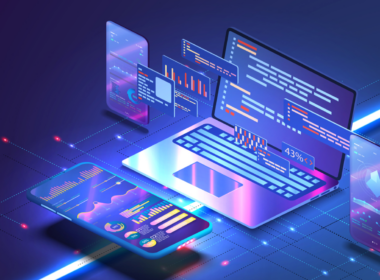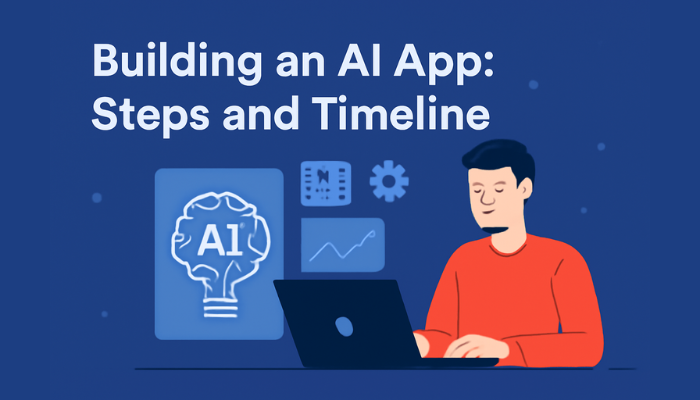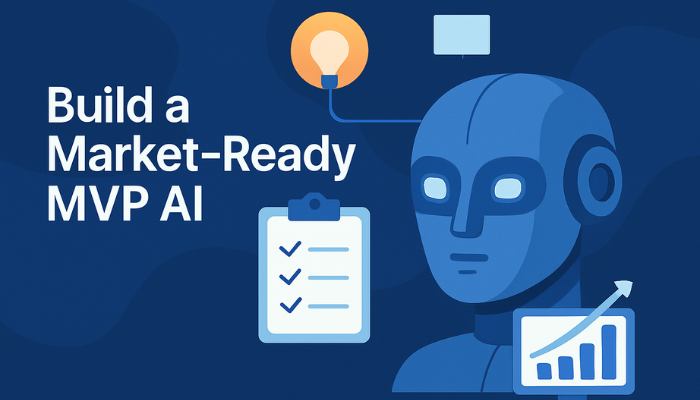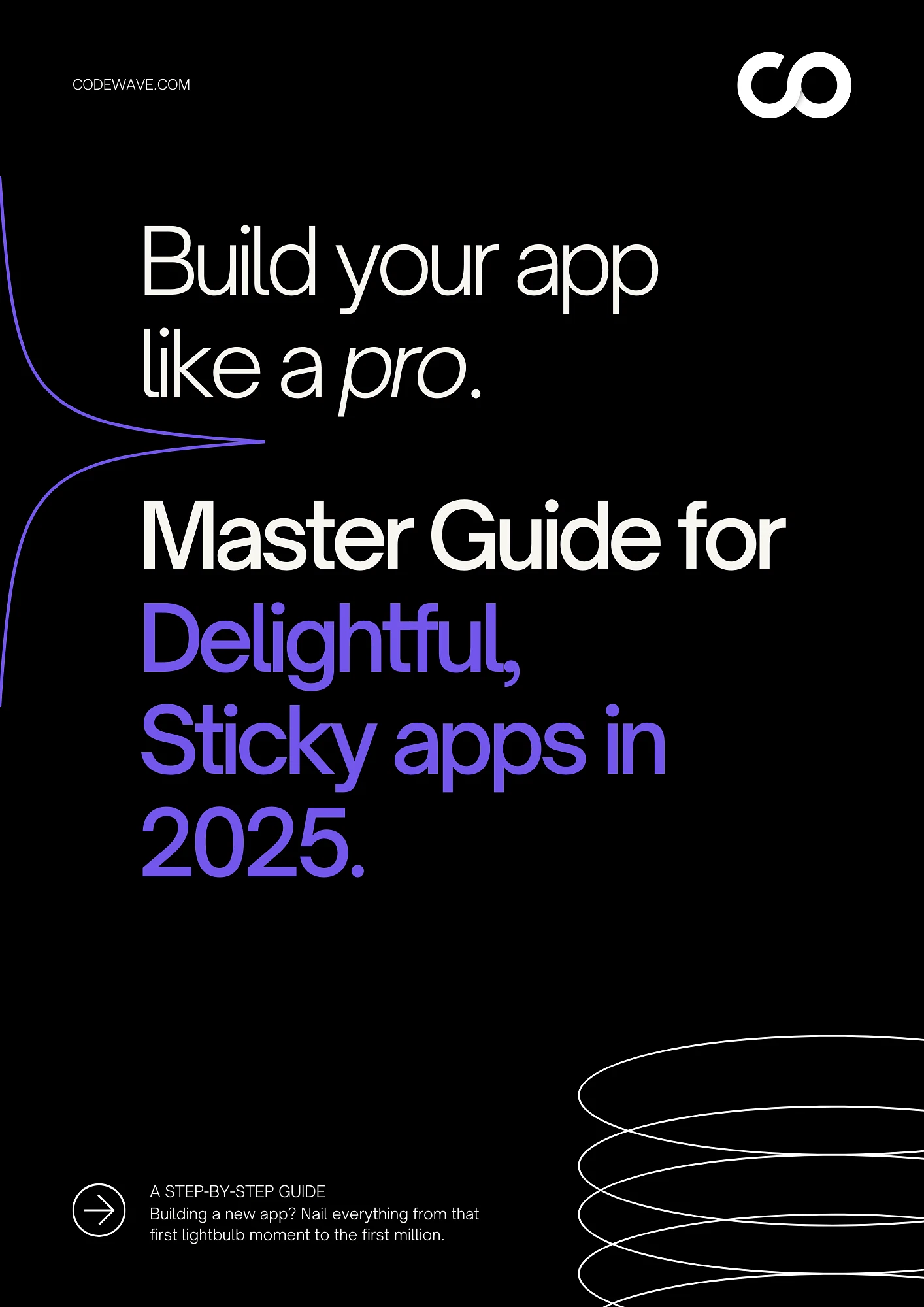Are you finding it hard to keep up with all the demands of running a business? Struggling to make quick decisions based on the right data? Is your team spending too much time on repetitive tasks instead of focusing on what really matters?
As a business leader or CFO, these are the challenges that can hold you back from growing or scaling your company. But what if there was a way to tackle these problems with an app that helps you make smarter decisions, save time, and improve your operations?
The truth is, building an AI app is more within your reach than ever. With the right tools, a clear plan, and a bit of guidance, your app can go from concept to reality, and it doesn’t have to be as complicated as you might think.
In this blog, we’ll show you how building an AI app could be the solution you’ve been looking for.
What is Artificial Intelligence?
Artificial Intelligence (AI) is a branch of computer science that focuses on creating machines capable of performing tasks that would normally require human intelligence. The goal is to build systems that can simulate human reasoning, decision-making, and learning.
Several well-known definitions help clarify AI’s scope and purpose:
- John McCarthy, who is often credited with coining the term “Artificial Intelligence,” defines it as “the science and engineering of making intelligent machines.”
- Stuart Russell and Peter Norvig, authors of the popular AI textbook Artificial Intelligence: A Modern Approach, define AI as “the study of agents that receive percepts from the environment and take actions that affect that environment.”
- Marvin Minsky, a pioneer in the field, described AI as “the science of making machines do things that would require intelligence if done by men.”
These definitions point to the core idea that AI is about building systems that can perceive, reason, and act in ways that replicate or enhance human capabilities.
With AI now clearly defined, you might be wondering, how does it all come together in an actual application? What makes an app “AI-powered,” and how does this transformative technology work within an app to enhance user experiences?
Let’s take a closer look at what exactly constitutes an AI app.
What is an AI App?
An AI app is an application that integrates artificial intelligence technologies to enhance its functionality, making it smarter and more adaptive. Unlike traditional apps that rely on static algorithms, AI apps are capable of learning from data, making predictions, and evolving over time based on user interactions and feedback.
In essence, an AI app isn’t just a tool with predefined commands. It’s a system that can improve, adapt, and sometimes even predict the user’s needs. Some of the most common AI technologies used in apps include:
- Machine Learning (ML): Enabling the app to learn from data and make decisions without being explicitly programmed. It helps apps become more accurate over time, like in recommendation systems or predictive typing.
- Natural Language Processing (NLP): Allowing the app to understand, interpret, and respond to human language. Think of chatbots or virtual assistants like Siri and Alexa.
- Computer Vision: Enabling apps to “see” and interpret visual data, which is commonly used in image recognition apps, medical diagnostic tools, and augmented reality experiences.
- Reinforcement Learning: A form of machine learning where an app learns through trial and error, making it ideal for applications like autonomous driving or gaming.
Traditional App vs. AI App
| Feature | Traditional App | AI App |
| Functionality | Predefined, static behavior based on user input | Dynamic, adapts and evolves based on user interactions and data |
| Data Processing | Uses hardcoded rules and algorithms | Learns from data, processes patterns, and improves over time |
| User Interaction | Limited to specific commands and responses | Can understand natural language, gestures, and adapt to different contexts |
| Updates and Learning | Requires manual updates or new versions to change behavior | Continuously improves through machine learning and feedback |
| Customization | Offers basic, one-size-fits-all functionality | Provides personalized experiences, tailoring content and actions to individual users |
| Complexity | Straightforward, task-oriented | Capable of handling complex tasks like predictions, recommendations, and decision-making |
| Examples | Weather apps, calculators, note-taking apps | Virtual assistants (Siri, Alexa), recommendation systems (Netflix, Amazon), autonomous driving apps |
These intelligent capabilities allow AI apps to deliver personalized experiences, make complex decisions faster, and continuously improve. From voice assistants like Siri to apps that suggest personalized content, AI is quietly powering some of the most popular technologies we use every day.
Why Build an AI App Now?
The time to dive into AI is now. The industry is exploding, and if you’re not on board yet, you’re missing out. In 2023, AI startups raised an incredible $23 billion, and more than 200 AI companies are now valued at over $1 billion. That’s a sign of just how quickly this technology is transforming everything.
AI isn’t something that’s going to happen someday, it’s happening right now, reshaping industries and creating opportunities you don’t want to miss. The sooner you jump in, the better positioned you’ll be to shape the future and be part of this fast-growing revolution.
Now that you begin building your own AI-powered app, it’s important to understand what it can achieve for your users. But how do you start the journey of developing such an app?
Let’s break it down into manageable steps.
1. Define the Objective and Challenges
Every great AI-powered app starts with a clear strategy and purpose. Before you explore AI tools or write any code, it’s essential to define why your app needs AI and how it will deliver value. AI has the power to personalize, predict, and automate, but its real impact comes from aligning your app’s goals with your business objectives.
Start by asking yourself:
- What problem is your app solving for users?
- Are you helping them search faster, recommend better options, detect risks early, or enhance customer support?
- How will the app deliver this solution in a way that makes an impact?
For example, a healthcare app might use AI to flag unusual patient records through real-time anomaly detection, allowing clinicians to prioritize the most critical cases. The goal is to help healthcare professionals focus on the right patients, improving their workflow and decision-making.
Anticipating potential challenges early on is key. One common issue is setting goals that are too broad or lack measurable outcomes. Instead of vague targets like “improve user satisfaction,” focus on specific actions or results, such as “reduce time spent on manual record-keeping by 30%.” This will help ensure your AI app stays aligned with measurable success.
2. Collect and Prepare Your Data
Once your app’s purpose is clear, the next step is gathering the data your AI model will learn from. The type of data you collect will heavily influence the AI’s performance, so it’s crucial to choose the right data sources. Here are some examples:
- Customer Data: Past interactions, behavioral data, and purchase history
- Images or Videos: For visual recognition tasks, such as in retail or security apps
- Text: Chat-based apps or content creation platforms
- Voice Samples: For voice recognition applications like virtual assistants
- Behavioral Logs: From app sessions or user activities
Different types of apps require different kinds of data. For example, a chatbot app needs natural language conversations, while a fashion app might rely on browsing history, product images, and user preferences.
Once you’ve identified your data sources, structure it carefully. This means organizing and labeling your data points, handling missing values, and ensuring that the data is clean and easy for your AI to process. Think of it as providing a well-organized training manual to teach your AI model.
3. Determine the Right AI Model
Now that your data is ready, it’s time to choose the right AI model. This choice is crucial for making your app smarter. Here’s a breakdown of models based on different use cases:
- Recommendation Systems: Collaborative filtering or content-based models
- Natural Language Processing (NLP): For conversational AI, use models like BERT or GPT
- Image Recognition: Convolutional Neural Networks (CNNs)
- Time Series Predictions: Recurrent Neural Networks (RNNs) or Long Short-Term Memory (LSTM) models.
The model choice depends on your app’s functionality and the type of data you’re working with. For instance, if your app needs to identify images, CNNs are effective, but for text-based apps, NLP models would be more appropriate.
You can also decide between using pre-trained models, which save time and resources, or custom architectures, which might be necessary for highly specific applications like legal risk engines or predictive maintenance in manufacturing.
4. Train Your AI Model & Validate Performance
With your model chosen, it’s time to train it. The goal here is to make the AI learn how to process input data and make predictions or decisions.
To train the model effectively, split your data into two sets: one for training and one for validation. A common approach is the 80/20 rule, where 80% of the data is used to train the model, and 20% is reserved for testing.
During training, monitor key metrics to evaluate the model’s performance:
- Accuracy: The percentage of correct predictions.
- Precision and Recall: Especially important if false positives or negatives matter (e.g., medical diagnoses).
- F1-score: Balances precision and recall for optimal performance.
- AUC-ROC: Measures the model’s ability to rank predictions effectively.
Use frameworks like TensorFlow, PyTorch, or Scikit-learn to manage your training process. Once the model is trained, test it on real-world scenarios and adjust it based on performance.
5. Build the App Architecture & Backend
Once your AI model is trained, it’s time to build the backend infrastructure that will support your app. You need to decide whether you’ll use cloud-based infrastructure (for scalability) or edge deployment (for offline or local data processing).
For example, a fitness app might process data on the user’s device using edge AI, whereas a chatbot typically relies on cloud servers for more complex computations.
The backend should include:
- API Layer: A secure API that connects your AI model to the app’s front end, allowing users to interact with the app in real-time.
- Data Storage: For logging user data and model predictions.
- User Authentication: To manage sessions and secure data.
- Queue Management: If your model processes tasks sequentially.
It’s essential that your backend is scalable, secure, and optimized to handle the app’s needs as it grows. Think of the backend as the engine powering your AI app, ensuring that it runs smoothly and efficiently.
6. Integrate Your AI Model into the App
Now that your AI model is trained and your backend is ready, the next step is integrating the model into your app. Whether you’re building a mobile app or web platform, you’ll need to connect your AI’s capabilities to the user interface.
For mobile apps, frameworks like TensorFlow Lite (for Android) and Core ML (for iOS) are designed to optimize models for mobile hardware. For web apps, APIs are typically used to send user inputs to the backend, which then processes them with the AI model and returns the results.
Key things to ensure during integration:
- Low-latency Responses: For a smooth and real-time user experience.
- API Security: Make sure data input and output are handled securely.
- Fallback Mechanisms: In case of failed predictions or system errors.
The goal is to make the AI feel natural and invisible to the user, offering them an intuitive experience with fast, accurate responses.
7. Test the AI-Powered App with Real Users
Before going live, thoroughly test your AI app with real-world users. Start with internal testing to ensure everything works as expected, including edge cases and speed. Then, move on to external testing with a controlled group of users.
During testing, focus on:
- Quantitative Metrics: Track performance such as response accuracy, latency, and app flow.
- Qualitative Feedback: Collect user opinions on the app’s usability and AI features.
Testing helps you identify any areas for improvement, whether it’s user interface issues, model performance, or inaccuracies in AI predictions.
8. Launch, Monitor & Continuously Optimize for Improvements
Once everything is tested, it’s time to launch your AI app. However, the work doesn’t stop there. Monitoring the app’s performance is crucial to ensuring long-term success.
Use tools like Sentry for performance monitoring and Vertex AI for model behavior analysis. Pay attention to user feedback loops (such as thumbs up/down, ratings, etc.), and regularly update your model to keep it aligned with new data.
Schedule regular retraining cycles to refine the model and ensure that the app continues to improve as more user data becomes available.
While building an AI-powered app is an exciting venture, it’s not without its hurdles. Developing an AI app comes with its own set of challenges, but with the right strategies, they can be overcome.
Also Read: Exploring Top AI Development Companies
Challenges in AI App Development (and How to Solve Them)
Let’s explore some of the most common challenges and how to tackle them:
1. Data Quality and Availability
One of the biggest challenges in AI app development is gathering high-quality, relevant data. AI models depend on data to learn and make predictions, but poor or insufficient data can lead to inaccurate models.
Solution:
- Data Collection: Ensure you have access to diverse, accurate, and clean data that aligns with your app’s goals. You can use public datasets, crowd-sourcing, or purchase proprietary data if necessary.
- Data Cleaning: Clean and preprocess data to remove duplicates, handle missing values, and standardize formats. This ensures that your AI model gets the most relevant input.
- Continuous Data Flow: Set up mechanisms to feed the app new data over time so the model can learn and improve continuously.
2. Choosing the Right AI Model
With so many AI models available, selecting the right one for your app can be overwhelming. The wrong model can result in poor performance, which could jeopardize the success of your app.
Solution:
- Understand Your Use Case: Choose a model that aligns with your app’s purpose. For instance, if your app involves recognizing objects in images, a Convolutional Neural Network (CNN) might be best. For chat-based apps, consider NLP models like BERT or GPT.
- Experiment and Test: Don’t hesitate to test different models and evaluate their performance with your specific data. If needed, combine models to create a hybrid approach.
3. Overfitting and Underfitting
AI models can either overfit (memorize the training data too well, losing the ability to generalize) or underfit (fail to capture important patterns in the data). Both are detrimental to the accuracy of your app’s predictions.
Solution:
- Cross-Validation: Use techniques like k-fold cross-validation to ensure your model generalizes well on unseen data.
- Regularization: Apply regularization techniques like L2 or dropout to prevent overfitting.
- Monitor Metrics: Track key metrics like accuracy, precision, and recall during training to find the optimal balance.
4. Real-Time Performance and Scalability
AI apps often require real-time processing, especially in use cases like chatbots or recommendation engines. Handling large amounts of data in real-time while maintaining performance can be challenging.
Solution:
- Optimized Infrastructure: Build a scalable backend that can handle the computational demands of real-time AI processing. Consider cloud services like AWS, Google Cloud, or Microsoft Azure for scalability.
- Efficient Algorithms: Use efficient algorithms and data structures to reduce computational overhead. For mobile apps, consider using lightweight models like MobileNet or TensorFlow Lite for faster performance.
- Edge AI: For offline or low-latency requirements, deploy models on the edge (on the user’s device) to reduce delays caused by network dependencies.
5. Ethical and Privacy Concerns
AI apps often process sensitive user data, which raises concerns about privacy, security, and ethical use of AI. Users are increasingly aware of how their data is used, so maintaining their trust is essential.
Solution:
- Data Privacy: Ensure that your app complies with data protection regulations like GDPR or CCPA. Use anonymization techniques and obtain user consent for data collection.
- Transparency: Be clear about what data is being collected and how it will be used. Offer users control over their data with settings for permissions and data deletion.
- Bias in AI: Be mindful of the data your AI models are trained on. Ensure that it’s diverse and free from biases to avoid discriminatory outcomes. Regularly audit your models for fairness and accuracy.
6. Integration Complexity
Integrating AI into an existing app or system can be tricky. It’s crucial to ensure that your AI model works seamlessly with the app’s core features without causing disruptions or bugs.
Solution:
- Modular Architecture: Build a modular app architecture that allows you to easily plug in AI functionalities without affecting other components.
- API Integration: Use RESTful APIs to communicate between the AI model and the app’s front-end, ensuring smooth data flow and real-time responses.
- Testing: Thoroughly test the integration in different environments (development, staging, and production) to ensure that everything functions as expected.
7. High Costs and Resource Intensive Development
AI app development can be resource-intensive, requiring significant computational power, specialized expertise, and continuous updates. The cost of training large models or processing vast datasets can be a barrier for many.
Solution:
- Cloud Computing: Leverage cloud platforms for AI model training and deployment, as they provide scalable resources without the need to invest heavily in hardware.
- Open-Source Tools: Use open-source AI frameworks like TensorFlow, PyTorch, or Scikit-learn to reduce costs and avoid expensive proprietary solutions.
- Outsource Expertise: If you lack in-house AI expertise, consider partnering with AI development agencies or outsourcing specific tasks to specialists.
Ready to bring your AI app to life without the sky-high costs? Let Codewave guide you through scalable solutions and cost-effective development.
With these solutions in mind, you’re ready to explore just how widespread the benefits of AI can be across various industries.
Benefits of AI Across Various Industries
AI is transforming industries globally by automating processes, enhancing decision-making, and improving efficiency. From healthcare to finance, retail to manufacturing, AI is unlocking new possibilities for growth and innovation.
1. Healthcare
AI is making a huge impact in the healthcare industry, helping professionals make better decisions, improve patient outcomes, and streamline processes. AI-powered apps are being used for everything from predicting disease outbreaks to personalizing treatment plans based on a patient’s unique data.
Examples:
- Diagnostic Tools: AI models are being trained to read medical images (like X-rays and MRIs) faster and more accurately than humans.
- Predictive Analytics: AI can help predict patient deterioration, allowing for early interventions.
2. Fintech
The fintech industry is embracing AI to improve customer experiences, automate financial services, and detect fraud in real-time. By analyzing large sets of financial data, AI can spot patterns and anomalies that human analysts might miss, enabling better decision-making and risk management.
Examples:
- Fraud Detection: AI models are constantly monitoring transactions to detect unusual activity and prevent fraud before it happens.
- Algorithmic Trading: AI is used to predict stock prices and automate trading strategies based on market trends.
3. Education
AI is changing how students learn and how educational content is delivered. Personalized learning platforms powered by AI can adapt to a student’s pace, strengths, and weaknesses, making education more engaging and effective.
Examples:
- Tutoring Systems: AI-driven chatbots provide real-time assistance and feedback to students.
- Curriculum Customization: AI helps educators create personalized learning paths for students based on their performance and learning styles.
Also Read: How AI and Farmers are Shaping the Future of Agriculture
4. Travel
AI is revolutionizing the travel industry by helping businesses offer more personalized services, optimize operations, and predict traveler behavior. From improving customer service to streamlining bookings, AI is enhancing the travel experience.
Examples:
- Smart Assistants: AI-driven chatbots assist travelers with booking, itineraries, and inquiries.
- Predictive Pricing: AI helps forecast flight and hotel prices, allowing travelers to book at the best possible rate.
5. Retail
Retailers are increasingly turning to AI to improve inventory management, enhance customer experiences, and streamline operations. AI helps retailers predict demand, personalize marketing efforts, and even assist with virtual shopping experiences.
Examples:
- Personalized Recommendations: AI in Retail suggests products to customers based on their browsing history and preferences.
- Inventory Management: AI is used to predict stock levels, ensuring that products are always available when customers need them.
Don’t just adapt to AI—lead with it. Get started with Codewave now!
Now that you understand the top 5 industries that benefit from AI development, let’s talk numbers. How much will it actually cost to develop your AI app? Here’s a quick breakdown:
Estimated Cost Range to Develop an AI App
| Type of AI App | Estimated Cost Range | Examples |
| Basic AI App | $30,000 – $60,000 | Simple chatbots, basic recommendation systems |
| Intermediate AI App | $60,000 – $120,000 | Apps with image recognition, natural language processing, or moderate AI complexity |
| Advanced AI App | $120,000 and above | Custom algorithms, real-time processing, apps handling large datasets |
As you can see, the complexity of your AI app will directly impact the cost. Simple apps are more affordable, while advanced, custom solutions will require a larger investment. The more sophisticated the AI functionalities, the higher the price tag.
Ready to Build an AI App That Works?
Building a successful AI app starts with a clear vision, aligning your goals with user needs and ensuring that the data supporting your model drives your app forward. When your app learns from user interactions, adapts over time, and consistently delivers value, it becomes a trusted tool for users.
At Codewave, we understand the importance of speed and scalability. With over 1000+ digital products delivered, a strong U.S. presence, and a development center in India, we specialize in AI App development services that are built for impact and scale.
You’ve learned the essentials, now it’s time to turn your vision into reality. Ready to get started? Let’s discuss your project and explore how our expert team can help bring your AI app to life.
Next Read:Revolutionizing Edge AI Development: Fast, Secure, Real-Time Solutions
Codewave is a UX first design thinking & digital transformation services company, designing & engineering innovative mobile apps, cloud, & edge solutions.







